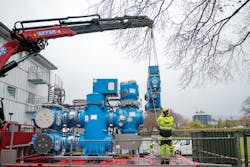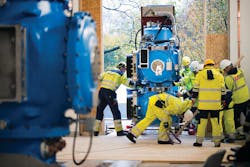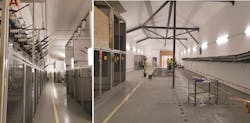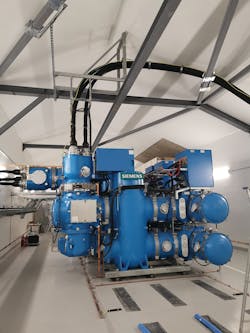Responsible for operating the distribution network in Norway, BKK Nett AS owns several companies engaged in many different areas of the electricity business, including operating hydropower plants, district heating systems, charging stations for electrical vehicles and communication networks. With distribution network voltages ranging from 132 kV to 230 V, BKK Nett supplies approximately 250,000 consumers in a number of municipalities located in western Norway, from Sunnfjord in the north to Etne in the south. Although BKK Nett is a regional and relatively small distribution network operator (DNO) in comparison with global DNOs, in keeping with its service territory and the rest of Norway, it has a major focus on the local environment and the need to minimize CO2 emissions in the transportation sector and other industries.
To meet this objective, the Norwegian government has introduced several fees to limit the total CO2 emissions, especially in city centers around the country. Furthermore, the European Union is considering introducing fees to limit the emission of SF6 gas, the insulating medium used in high-voltage switchgear. BKK Nett has taken a small step for the climate change facing the world but a giant leap forward for a small DNO by being the first utility to buy and install the climate-friendly blue gas-insulated switchgear (GIS) at the 132-kV voltage level manufactured by Siemens AG.
An Existing Substation
When commissioned in 1965, the 45-kV substation K was equipped with a 45-kV indoor switchgear comprising air-insulated circuit breakers, four 45/11-kV transformers each rated at 20 MVA and an 11-kV indoor switchgear also equipped with air-insulated circuit breakers. Since then, BKK Nett had to remove two transformers and replace the 11-kV circuit breakers with new compact breakers. Nearing the end of its service life, the 45-kV switchgear also was due for replacement. Furthermore, in some extraordinary instances, the 45-kV circuit breakers required manual operation without the benefit of interlocking, because of the design of the breakers. This operational procedure does not meet today’s safety standards.
BKK Nett had an established general strategy to upgrade the voltage level in the area from 45 kV to 132 kV to increase network flexibility and supply the increasing energy demands from its residential and business consumers. In line with this strategy, the DNO planned to replace the high-voltage switchgear and extend substation K with two 132/11-kV transformers. Following this refurbishment project, the substation would be equipped with two 45/11-kV transformers directly supplied from a nearby substation, two 132/11-kV transformers controlled by the new blue GIS switchgear and 30 11-kV feeders to supply consumers, including a shore connection to cruise ships.
This project coincided with a request from a large power consumer for an additional 32 MW, increasing their total maximum power requirement from 1.3 MW to 33.3 MW. This would require the consumer to be supplied at 11 kV. The consumer supplies cruise ships with a shore connection and is experiencing an increase in the number of cruise ships that require an electrical shore connection while docked at the port. The ships that berth in a bay close to substation K each would be able to request a power supply ranging from 3.5 MW to 12.5 MW for the periods they are in port, thereby eliminating the need to have their diesel generating facilities in operation.
Blue GIS Selection
Because of the location of substation K and the planned voltage upgrade, expectations of the leaders at BKK Nett and the government were for the substation to be climate friendly. In addition, there was an opportunity for the substation to reduce the environmental impact of the transportation/tourism sector by providing power supply services to visiting cruise ships.
According to the Norwegian Environment Agency, SF6 is 22,800 times more pollutive than CO2. BKK Nett—which focuses on being a green company—seeks green choices for the future. Therefore, with its substation K refurbishment project, the DNO decided to consider the complete range of climate-friendly GIS being promoted by several high-voltage switchgear manufacturers.
BKK Nett chose to sign an agreement with Siemens because of its technological design and the use of vacuum as a switching and interruption medium together with clean air as the insulation medium. Siemens calls this blue GIS. Clean air, or purified air, comprises a mixture of 80% nitrogen to 20% oxygen. The use of these known mediums makes it more predictable regarding safety during maintenance and avoids any eventual restriction using a new type of gas as an alternative.
The blue GIS would control the main distribution network feeders that supply the substation, thereby also supplying cruise ships with a shore connection to reduce the local pollution from the ships while in port. This makes the power to these cruise ships green energy entirely, from the hydropower plants and transmission system to the distribution network and cruise ships. This objective proved to be a suitable site to consider substation K as a pioneer substation equipped with blue GIS.
The contract with Siemens to supply, engineer and commission the blue GIS as well as install the protection system and 11-kV feeders was signed in November 2018, with a planned delivery to site of the new blue GIS in October 2019.
Substation Upgrade
BKK Nett has a responsibility to supply both existing and new consumers with the power they demand. Fortunately, the utility had prognosticated an increasing demand for power to supply the cruise ships by a shore connection. It started preparing for this several years ago by upgrading and expanding an existing adjacent substation from 45-kV to 132-kV voltage level. The adjacent substation A was equipped with new transformers and new 132-kV switchgear, including provision for an additional 132-kV underground cable feeder for substation K.
The route for the future 132-kV cables to substation K also was established. Under construction for 10 tears, the cable duct from substation A to substation K is more than 2 km (1.24 miles) long, crossing a city center. When excavating the cable duct run for the 132-kV cables, ducts for 11-kV cables, communication cables, district heating, water and wastewater services were installed at the same time. The mutual cooperation by the utilities responsible for the other infrastructure services installed underground ensured the cable route was established with a minimum impact on the local environment and the
citizens of the city.
The contract for the new 132-kV blue GIS, with a rated current of 3150 A and a short-circuit rating of 40 kA, included two transformer bays and one cable bay with provision for several bays in the future. The blue GIS is rated for 145 kV and has the same mechanical characteristics and dimensions of a regular 170-kV GIS with SF6 gas. However, the dimensions, weight and placement of the new GIS in the existing high-voltage switch room in the substation was an issue. The dimensions of the switch room were on the borderline of being too small to accommodate the new blue GIS in addition to the new incoming 132-kV cables and their increased bending radius.
To release some of the available space, BKK Nett installed a new technology to replace conventional current and voltage measurement transformers: low-power instrument transformers (LPIT). LPIT technology makes it possible to flexibly parameterize the measuring and protective systems according to specific requirements. Transmitting the data over a fiber-optic cable reduces the length of wiring required, but there is no backup solution with the conventional measuring and protection systems used. As a bonus, the GIS dimensions and overall weight with LPITs was reduced by 20% compared to a GIS with conventional measurement transformers. Nevertheless, BKK Nett had to calculate the static and dynamic strength of the building to confirm it could handle the weight and forces during a switchgear breaking operation.
In addition to removing the existing 45-kV circuit breakers from the switch room, the substation civil works also required some adjustments to the building. The oil-pressure system and housing for the existing incoming oil-filled 45-kV cables had to be removed. Further work also was required to install a new earthing system in the floor construction for the GIS, a transportation door to get the GIS into the switch room, holes for new incoming 132-kV cables, holes for new 132-kV transformer cables and a roof crane to replace vacuum tubes in the circuit breakers, when the need arises in the future.
All the reconstruction works and reported issues were known and programmed in advance. In fact, the new blue GIS with LPIT proved to be more suitable for use in the existing substation because the design was more compact than conventional GIS. Furthermore, BKK Nett will have a long-term benefit in terms of reduced maintenance cost, as it no longer needs to consider all the safety procedures associated with maintaining components containing SF6 gas.
Project Organization
BKK Nett appoints a project manager for its major construction works who is responsible for all outsourced contractors. For the substation K project, the engineering and civil works were undertaken by Sweco Norway AS and Minimaskin AS. BKK Enotek AS, a daughter company of BKK AS, completed the engineering and commissioning of the incoming 132-kV cable and 11-kV cables, while BKK Nett installed the cable duct from the nearby substation to the consumers. The project cost some 60 million Norwegian krone (US$5.9 million).
From the time BKK Nett started discussing the application of climate-friendly switchgear to the completed commissioning of substation K in May 2020, a period of two years elapsed. The well-managed numerous resources worked together successfully on the first installation of blue GIS, which has drawn global attention to the small DNO in Norway.
Low Power Instrument Transformers
Likewise, LPITs are a new technology that has had a limited number of applications to date. BKK Nett encountered some difficulties with the configuration of these new protection systems. Siemens has continued with further development so protection systems can take full advantage of LPITs. However, because of the project schedule, the latest version of LPITs has not yet been implemented in substation K’s protection system. LPITs are an important step forward to establish a digital substation, the direction BKK Nett wants to go with substation K.
BKK Nett has been a pioneer in erecting a digital substation in another recently completed project. In this substation, the installed conventional transformers use a merging unit in the outdoor switchgear to reduce the copper wiring to a minimum. Fiber-optic cables connect the merging unit to the control system.
The adoption of these new green technologies are forward-thinking decisions for a small DNO like BKK Nett. However, the utility has a conscious attitude toward making decisions that facilitate green solutions all the way from climate-friendly hydropower energy production to end consumers. BKK Nett aims to lead by example by contributing to a more climate-friendly society.
Ruth Helene Kyte holds a master’s degree from the Norwegian University of Science and Technology and has nine years of experience in energy management and engineering. For the past three years, she has worked as project manager on major construction projects at BKK Nett AS, including the substation K project.
About the Author
Ruth Helene Kyte
Ruth Helene Kyte ([email protected]) holds a master’s degree from the Norwegian University of Science and Technology and has nine years of experience in energy management and engineering. For the past three years, she has worked as project manager on major construction projects at BKK Nett AS, including the substation K project.




